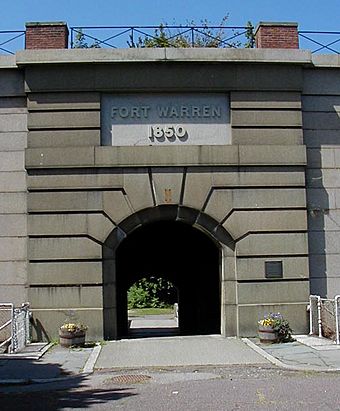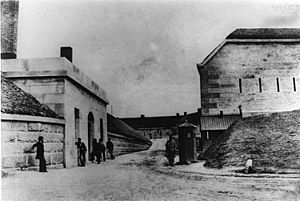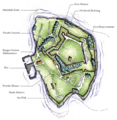Fort Warren (Massachusetts) facts for kids
|
Fort Warren
|
|

Fort Warren's sally port
|
|
| Location | Boston, Massachusetts |
|---|---|
| Area | 40 acres (16 ha) |
| Built | 1834–1860 |
| Architect | Thayer, Lt. Col. Sylvanus; Army Corps of Engineers |
| Architectural style | Third System fort |
| Part of | American Civil War prison camps (1861–1865) Harbor Defenses of Boston (1899–1947) |
| NRHP reference No. | 70000540 |
Quick facts for kids Significant dates |
|
| Added to NRHP | August 29, 1970 |
| Designated NHLD | August 29, 1970 |

Fort Warren is a famous historic fort located on Georges Island. This island is at the entrance to Boston Harbor in Massachusetts. The fort is named after Dr. Joseph Warren, a hero from the American Revolution. He was known for sending Paul Revere on his famous ride. Dr. Warren later died at the Battle of Bunker Hill.
Fort Warren is shaped like a pentagon and is a bastion fort. It was built using strong stone and granite between 1833 and 1861. Construction finished just after the American Civil War began. The fort protected Boston Harbor from 1861 until the end of World War II. During the Civil War, it was a prison for Confederate officers and government officials. This included Alexander H. Stephens, who was the Confederate Vice President.
The fort was also active during the Spanish–American War and World War I. It was used again during World War II. Fort Warren was officially closed in 1947. Today, it is a popular place for tourists to visit. In 1970, it was recognized as a National Historic Landmark. This was because of its amazing design and its important role in the Civil War.
Contents
Building a Strong Fort: Early History
Fort Warren was built between 1833 and 1861. It was finished shortly after the American Civil War started. This fort was part of the "third system" of US coastal defenses. These defenses were built to protect the country's shores.
Colonel Sylvanus Thayer was the Army engineer in charge of building most of the fort. He is also famous for being the leader of the United States Military Academy at West Point. Fort Warren was the fifth largest of the 42 forts in this "third system." Its design was a slightly uneven pentagon. This shape helped it fit perfectly with the island's natural landscape.
The fort shows off excellent granite stonework. It also has a special "demilune" (half-moon) battery. This protected the north entrance, called a sally port. This feature is quite rare in US forts. Fort Warren was first designed to hold over 200 guns. During the Civil War, it was armed with large 15-inch and 10-inch Rodman smoothbore guns.
Fort Warren During the Civil War
During the Civil War, Fort Warren became a prison. It held captured soldiers and sailors from the Confederate States of America. It also held government officials from Maryland and some Northern political prisoners. Colonel Justin Dimick commanded the fort from 1861 to 1864. He was known for treating the Confederate prisoners kindly.
Out of more than 1,000 Confederate prisoners, only 13 died at Fort Warren. This was a much lower death rate than any other prison camp during the Civil War. Important people held here included James M. Mason and John Slidell. They were Confederate diplomats involved in the Trent affair. Other famous prisoners included Confederate Vice President Alexander H. Stephens.
The prison camp had a good reputation for how it treated its prisoners. Once, when Colonel Dimick's son, Lieutenant Justin E. Dimick, left for active duty, Confederate officers at the fort gave him a letter. It asked for good care if he were ever captured. Sadly, he was later badly wounded in battle.
On August 19, 1863, six prisoners tried to escape. Two were caught on the island, and two more were caught while trying to sail to Canada. The authorities believed the other two drowned while swimming to shore.
A famous Union marching song, John Brown's Body, was written at Fort Warren. It used an old Methodist camp song tune. The song was first performed at a flag-raising ceremony there on May 12, 1861. Soldiers from the "Webster Regiment" (the 12th Massachusetts Infantry) took the song to the main Union army. Later, Julia Ward Howe heard this song. She was encouraged to write new words for it. Her poem, The Battle Hymn of the Republic, was then set to the same tune. It became one of the most memorable songs of the Civil War.
Upgrades and New Guns: After the Civil War
In the 1870s, Fort Warren was updated with new gun batteries. These were armed with Rodman guns. A special plaque at the fort explains that one part of the fort was roofed over. This created a unique covered battery for a 15-inch Rodman gun. The huge brick arches built to enclose this area are very impressive.
From 1892 to 1903, Fort Warren was rebuilt again. This was to hold modern, powerful guns that loaded from the back. This project was part of the "Endicott program." Five new gun batteries were added to the fort. These replaced some of the older gun positions.
The fort's main weapons were two 12-inch and five 10-inch guns. These were designed to defend against enemy battleships. To protect against smaller ships, like those clearing mine fields, the fort also had two 4-inch and three 3-inch guns. One battery, called Battery Adams, was built with poor concrete. It was taken out of service in 1914 because it was falling apart.
World War I and World War II Roles
Fort Warren served as the main command center for the Coast Defenses of Boston during World War I. Between 1917 and 1918, four of the 10-inch guns were removed. They were considered for use as railway artillery on the battlefields of Europe. While some 10-inch guns were sent to France, it seems none were actually used in battle during World War I. Different 10-inch guns replaced these weapons in 1919.
After World War I ended in 1920, several types of weapons were removed from coastal defense. This included the 4-inch guns and 3-inch guns at Fort Warren. These were not replaced. The 4-inch guns stayed at the fort as display pieces until at least 1941.
During World War II, the fort became a control center. It managed Boston Harbor's southern mine field. This was a safety measure in case German Kriegsmarine U-boats attacked. The 241st Coast Artillery Regiment, a Massachusetts National Guard unit, was stationed at Fort Warren. As newer, larger batteries were built elsewhere, Fort Warren's remaining guns were removed and scrapped between 1942 and 1944. Fort Warren was permanently closed after 1950.
Visiting Fort Warren Today
The U.S. federal government owned Fort Warren until 1958. Then, the state of Massachusetts took ownership. In 1961, after some initial repairs, the fort was opened to the public.
Today, the Massachusetts Department of Conservation and Recreation manages the fort. It is a main attraction of the Boston Harbor Islands National Recreation Area. You can reach the fort by ferry from downtown Boston, Hingham, or Hull. From Georges Island, you can also take ferries to other nearby islands.
The fort is usually open from May through Columbus Day weekend. Park rangers offer guided tours, or you can explore on your own. An information booth near the main entrance (sally port) tells you about activities. The island has a snack bar, water fountains, and many restrooms. There is also a museum in the old mine storehouse. You can find picnic tables and a children's play area too.
Visitors can walk on top of some walls and explore some of the rooms and storage areas below. Near the ferry dock, you can see two Civil War 3-inch rifled guns. These were changed to load from the back. The fort also displays 10-inch Rodman guns, old projectiles, and two World War II 40 mm Bofors guns. The museum includes a model of a disappearing gun and a Nike-Ajax missile.
A Confederate Memorial
A headstone remembering 13 southern soldiers who died while imprisoned during the Civil War was once on the island. It was installed in 1963 by the Boston Chapter of the United Daughters of the Confederacy. In June 2017, Governor Charlie Baker asked for the memorial to be removed. The state then covered and removed the monument in October 2017. It is now stored in the Massachusetts State Archives.
Images for kids
See also
- List of Civil War POW Prisons and Camps
- 9th Coast Artillery (United States)
- 241st Coast Artillery (United States)
- List of National Historic Landmarks in Boston
- National Register of Historic Places listings in southern Boston, Massachusetts
- Seacoast defense in the United States
- United States Army Coast Artillery Corps
- List of military installations in Massachusetts


















